Church Point's Thomas Stephens Reserve Landscape works: Do post-consultation changes announce installing Rubber crumb products alongside the Pittwater Estuary? + works may commence in 2025 + McCarrs Creek Road Safety Updates
Council advised on October 3rd 2024 the final design plan and materials palette are now available for its plans for Thomas Stephens Reserve at Church Point and it is preparing documents for tender.
This project, for which consultation was held from April to May 2024, now has a finalised design.
Council documents state the modified design now includes the use of permeable paving and permeable tree surrounds, the repositioning of the bike rail, the retention of the existing sandstone planter at the street front, and the deletion of the proposed timber block seating along the seawall.
Pittwater Online News was contacted by residents on notification of the updated design with fears products containing plastic and rubber granules were to be installed, post-consultation, beside the estuary.
Permeable tree surrounds contain rubber granules.
Permeable pavers also contain rubber granules.
Everyone who visits this reserve beside the Church Point wharf knows how much wear and tear it undergoes due to the popularity of the site with residents and thousands of annual visitors.
The news service also received queries as to where funding allocated in past Council budget announcements had gone.
The Council budget allocation in 2024/25 lists ‘’Church Point landscape and paving upgrade Budget: $600,000 for Start Jul-24 and Completion Jun-25
Council's Capital Works map and literature, also allocated at Church Point: Project Public Amenities Works Program Work Renewal works to Church Point Public Amenities Budget $499,477 Start Jul-24 Completion Jun-25.
These queries were forwarded on to Council, which confirmed:
''The unused allocated funding for this project is rolled over to the following financial year to complete the project. ''
However, direct queries as to whether the natural products consulted on were now being swapped out post-consultation for ones that may leach or disperse into the waterways received an opaque reply which addressed, in part, the query about the pavers now announced to be used and no answer as to what tree guards will be composed of:
''Although the specific product has not been selected it will be a concrete paver that does not include plastic.''
The May 2024 landscape plan, consulted on, included a Porphyry pavement area to be installed. Porphyry is any of various granites or igneous rocks with coarse-grained crystals such as feldspar or quartz dispersed in a fine-grained silicate-rich, generally aphanitic matrix or groundmass - and 100% natural.
On Monday October 21 2024 Council sent in the follwing clarifications:
''Generally, permeable pavers are made from fired clay brick or concrete with crushed aggregate filling the joints between the pavers. They do not contain rubber or plastic.
The tree surrounds are proposed to be a resin bound gravel, which stabilises the loose gravel while still allowing oxygen and water to penetrate. This removes the need to excavate around the tree roots which would have a detrimental impact on the tree’s health. There are no permanent tree guards proposed in the revised plans.''
Council stated community engagement took place between 23 April and 23 May 2024 and received 123 comments. However, the engagement report records 21 of these were 'intentionally left blank'.
''Since that time we have been reviewing and incorporating the feedback from our community, key stakeholder groups and internal business stakeholders.'' Council states on its project webpage for the landscaping works
''We have made a number of changes to both the landscape design for Thomas Stephens Reserve and the proposed road realignment works. Some suggested changes have been accommodated while others are not supported due to, cost, varied community design desires or internal feedback from our various asset owners and maintenance operations within Council.
''Our intention is to find the right balance between the wishes of community members and users whilst creating improved amenity and well managed assets with a quality outcome for the budget available.
You can read the Council's Community Engagement Report to learn more - including the key themes that emerged during consultation, the Council's responses and the community's verbatim comments.''
Visit: yoursay.northernbeaches.nsw.gov.au/church-point-commercial-centre-upgrade
The October announcement, to those subscribed to receive updates on this project and now worried, at least precludes finding plastic or rubber has been installed without community consultation, and without including the presence of the same in the Plan of Management (PoM) as has occurred at Lynne's Park in Warriewood, where the first time residents found out this has happened was through the official opening of the same. The park sits beside a fast flowing creek known to flood this park area.
See: Synthetic Turf Installed in Pittwater Without Consultation - May 2024
Soft-fall plastic installed at Newport beach showed this had deteriorated soon afterwards.
See: Newly Installed Synthetic 'Soft' Pad At Newport Beach Outdoor Youth Space Already Deteriorating: The Holes In Choosing A Poison Over The Natural More Apparent In 2023 - January 2023
The problems associated with plastic products in natural environments have been well-documented by now. In September 2023 AUSMAP, a nation-wide academics and university led citizen science initiative surveying Australian beaches for microplastic pollution, stated they have been working with a Council in Sydney’s north-west on quantifying net microplastic loss from a synthetic turf field and the efficacy of stormwater pit traps.
- Impose a 5-year moratorium on new planning and approvals for synthetic grass fields.
- Subject existing fields to pollution mitigation measures as soon as possible.
- Urgently develop end-of-life pathways (recycling?) for fields that will not cause damage (their case study identifies the only one in Australia, which is 10 years old and with Australian conditions mean they have shorter lifespans than overseas cases).
- Invest substantial effort into how to improve drainage and condition of natural grass fields to avoid synthetic grass.
- Continue a research program including epidemiological or health risk studies, heat impacts, environmental impacts, chemical composition, stormwater discharge, microplastic loss etc.
The guidelines aim to help decision-makers, planners and sports field managers who may be considering synthetic turf as an alternative to natural grass. They will also support designers, delivery agents and open space managers to plan and deliver the best outcome for their community.
• Post-installation inspection of unitary (e.g. rubber) surfacing in accordance with the requirements of AS 4422.• Unitary (e.g. rubber) surfacing should be tested at least every 3 years.• Loose-fill surfaces need not be impact attenuation tested on a regular basis providing:1. the generic product typically complies with the requirements of AS 4422 when tested; and2. that the material is maintained at a minimum depth of 200 mm (or greater where free heights of fall require a greater material depth).
See:
- Newly Installed Synthetic 'soft' pad At Newport Beach Outdoor Youth Space Already Deteriorating: the holes in choosing a poison over the natural more apparent in 2023
- Council Announces Its Proposal To Install Synthetic Field At North Narrabeen Reserve - Draft Will Be Open For Feedback After Autumn School Holidays: State Government Seeking Feedback On Draft 'Guidelines' For Synthetic Turf In Public Spaces seen as 'cop out'
- Council proposal to install soft-fall rubber + synthetic grass at Dee Why Beach Playground for very young children
At Newport Beach: November 2022 a year and a half on from installation
Council's Concept Plans for Thomas Stephens Reserve, Church Point - dated September 30 2024:
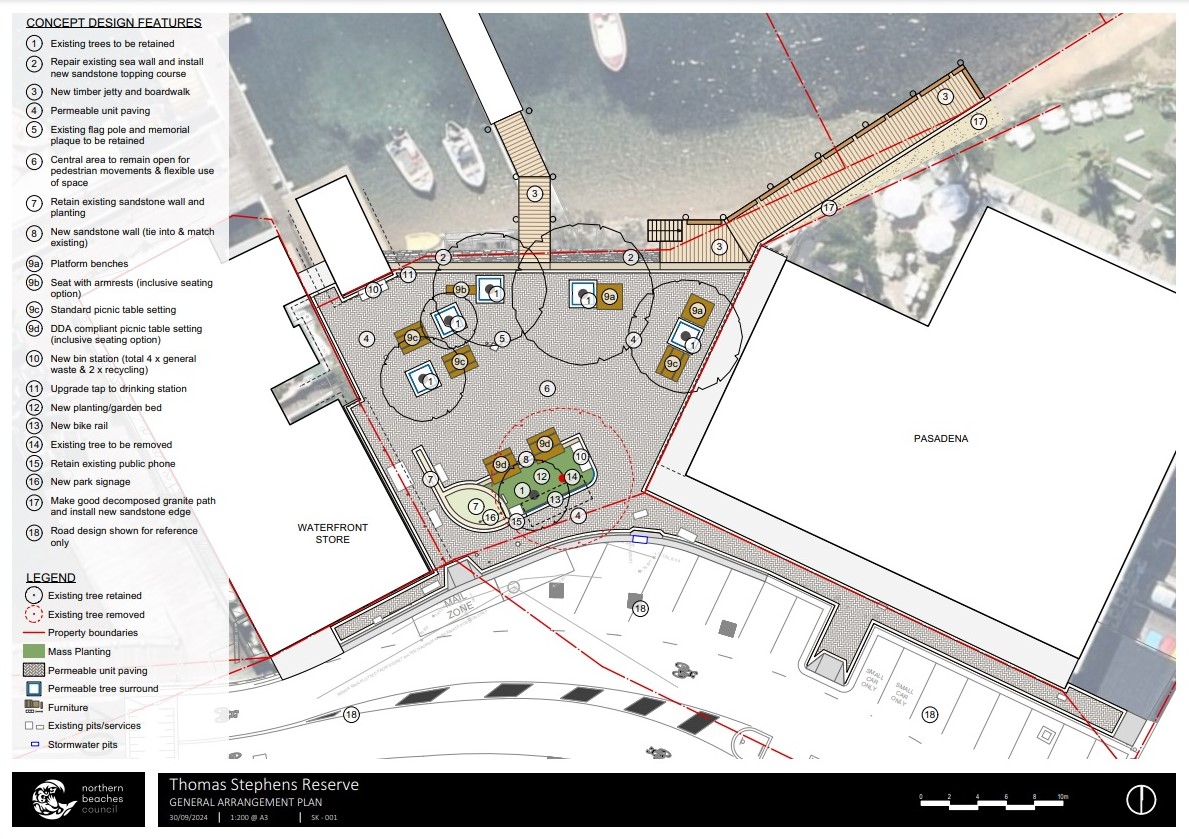
Council stated in its October 3 2024 update;
''the final landscape design is the result of extensive consultation with community groups, key stakeholders and experts including arborists, as well as incorporation of community feedback. We've also taken into account any recent DAs and input from key local community and resident groups.
The overarching design brief is to create an accessible space. Some key changes include the ability to retain some trees and not others.''
However, not one resident has been consulted about whether they support the last-minute change from something 100% natural to something that may 100% fake edging the Pittwater estuary.
Council states it anticipates the landscape works will commence mid-2025 and will confirm the timing once the tender processes are complete and works are ready to commence.
The 2024-2025 passed Capital Works Program, via Council's map and literature, allocated the following at Church Point:
Project Commercial Centre Renewal
Work Church Point landscape and paving upgrade
Budget $600,000
Start Jul-24
Completion Jun-25
Project Public Amenities Works Program
Work Renewal works to Church Point Public Amenities
Budget $499,477
Start Jul-24
Completion Jun-25
Project Church Point - New Infrastructure
Work McCarrs Creek Road
Budget $862,500
Start Jun-24
Completion Dec-24
Council's webpage for the project also states a 'key focus area' was the retention of the trees adjacent to the seawall. These were initially proposed to be removed due to the age of the trees and safety concerns raised during Council's first appraisals.
Council states:
''As part of the modified design, every effort will be made to retain the two trees in this area. It is acknowledged that this area will be the most heavily impacted by the construction works, and an arborist site assessment will determine the viability of retention at that time.''
Which leaves it to the last minute to then decide to remove them when residents cannot do anything about it, as seen in the years long push back against a fill the whole block with way over the height limit concrete shop-top housing design for the old fish and chip shop site at Palm Beach being supported by Council during the legal processes.
Council not supporting residents aspirations has also been cited in the recent Ruskin Rowe Tree Vigils.
As stated by those who attended the recent Ruskin Rowe Tree Vigils, the Council has removed over 30 thousand trees across the LGA since being installed by the coalition government, and claims to have installed over 20 thousand - mostly seedlings.
The two remaining trees are still scheduled for destruction in October 2024.
Council's most recent Budget announcements have a focus on;
''resilience and environmental sustainability, prioritising projects and services that support and strengthen our community and environment.''
With Council announcing that;
''The Northern Beaches will benefit from services and projects totalling $524 million, including an injection of $99 million in infrastructure spending, outlined in the 2024/25 Northern Beaches Council budget.
''The proposed $99 million capital works program includes $43 million in asset renewal to improve the overall condition of our assets and to reduce ongoing operational costs associated with asset repair and maintenance. A further $56 million will deliver high priority new assets to the community.''
The proposed landscape improvements at Thomas Stephens Reserve include new:
- boardwalk and pavement
- wharf style seating
- tables and benches
- repointing and backfilling of the existing seawall
- bins, bike racks and water station
- plantings and trees.
Church Point: 2 projects now
In May 2024 Council provided the outcomes of the initial community engagement on both the landscape improvements, and the road safety upgrades. Council decided to separate these projects to report independently, ''for ease of tracking and updates on next steps for each program of work''.
McCarrs Creek Road - Road Safety Upgrade
Council states it received comments from the local community as part of the Church Point Precinct Upgrade consultation. The comments included requests for traffic and other improvements within the Church Point Precinct to address safety issues.
Two external road safety assessments were undertaken - the most recent in February 2024 - to review and include improvements to traffic and safety.
Council states ''the new design layouts meet both the community and road safety assessment requirements. Cost effectiveness and reduction in clearing works to the existing landscape have also been factored into the new design.
With the design changes and the length of time since initial consultation, we wanted to ensure we consult with our community before we move toward construction.''
Council subsequently asked residents to comment on their proposed road safety upgrade from 3 June to 1 July 2024. Council states it heard from over 55 community members and are currently reviewing your feedback on the road safety upgrade and writing a Community Engagement Report.
''We anticipate the road works commencing mid-late this year (2024) following the completion of a review of environmental factors (REF) that is currently underway and will be available for public review.'' Council's webpage update states
''It is anticipated that two spaces will be lost from the existing parking. These two lost spaces account for the two new pedestrian crossing islands that are required to safely cross McCarrs Creek Road and to cross the carpark to the toilets and the bus stop.''
The roads will remain open throughout the works with traffic management in place when required to safely work through the construction.
Working hours will be Monday to Friday 7am – 5pm and Saturday when required will be 7am – 1pm.
There will be minor night works for the road line markings, but these works will be quiet, non-impact works.
Notifications to local residents and businesses will be issued prior to any works commencing.
To make Church Point safer for pedestrians and road users by implementing road safety improvements, Council's plan includes:
- a pedestrian refuge to provide safer pedestrian access to/from the bus stop
- safety improvements to bus stop
- traffic calming devices
- line delineation to separate laneway and parking areas
- improved signage
- new Watts profile thresholds
- footpath upgrade on southside of road
- some kerb and guttering.
All existing trees will be retained as part of this proposal.''
This would be the second round of improvements along the Pittwater Road and McCarrs Creek sections from Mona Vale to Church Point, Council having recently completed safety works at Bayview.
Visit: Bayview's rejuvenated path + seawall completed - July 2024, Issue 632
And this follows on from the completion of other aspects of Church Point rejuvenation works undertaken.
Visit: Church Point Precinct Upgrade Scheduled To Be Completed This Financial Year: Boardwalk Completed In December 2022 Now A Popular Suntrap For Residents + Visitors Beside The Estuary + Scotland Island Bells And Carol Wharf Upgrades Completed - July 2023, Issue 592 update
Council's Concept plans, via the McCarrs Creek Road Safety Upgrades webpage, are:
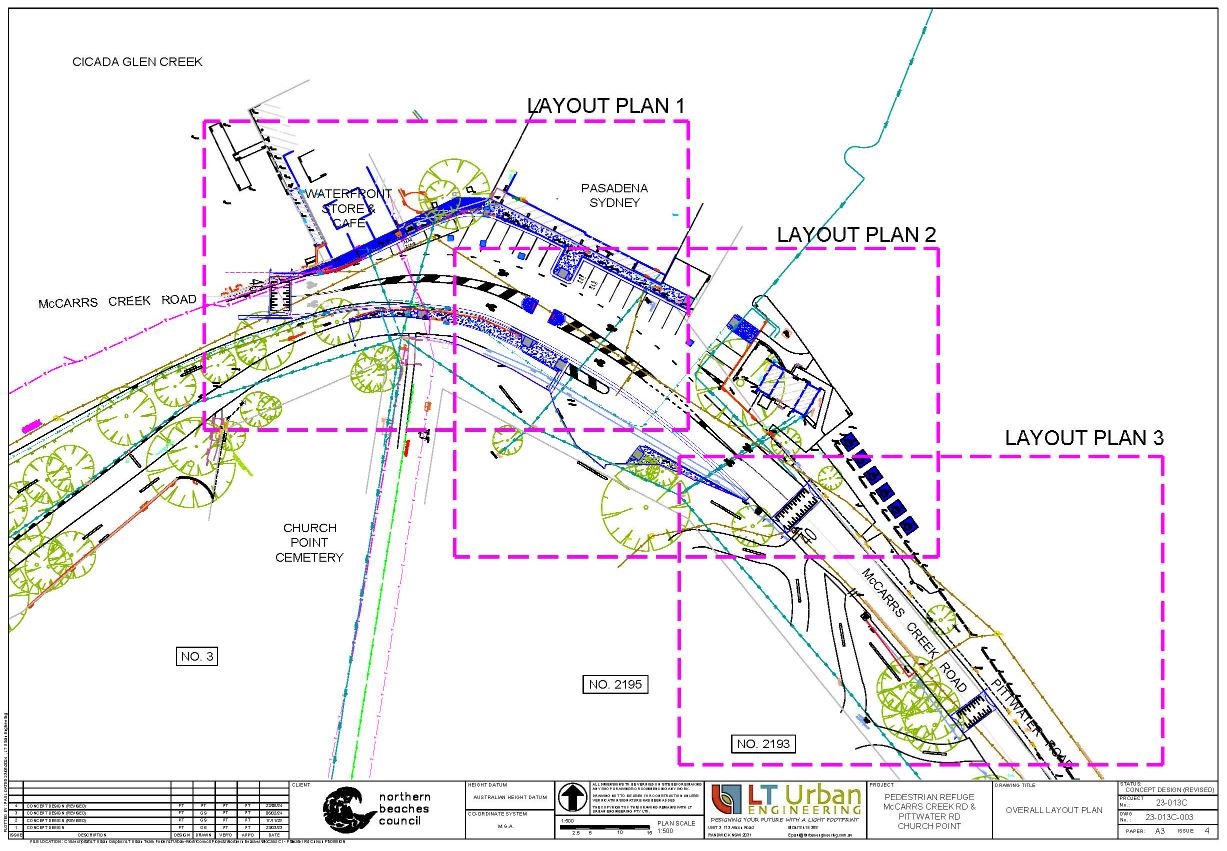
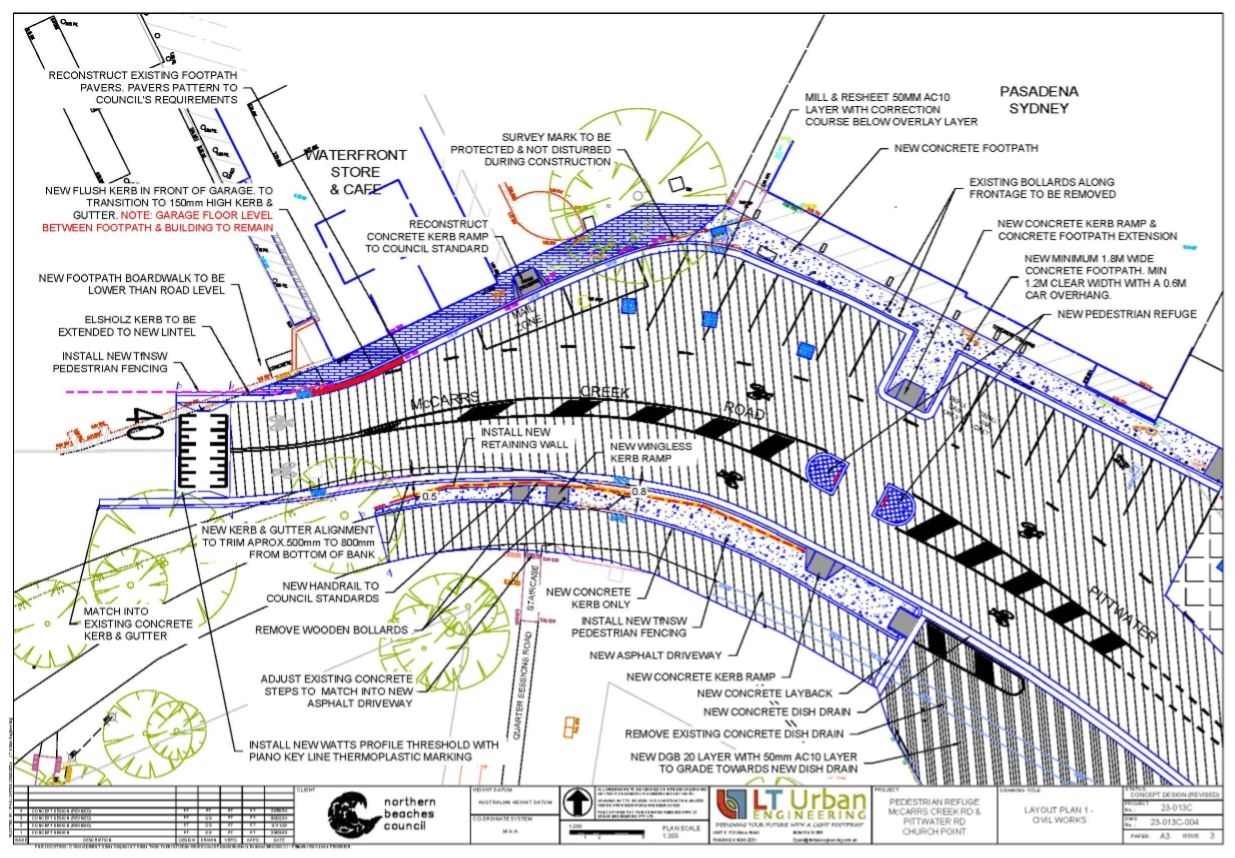
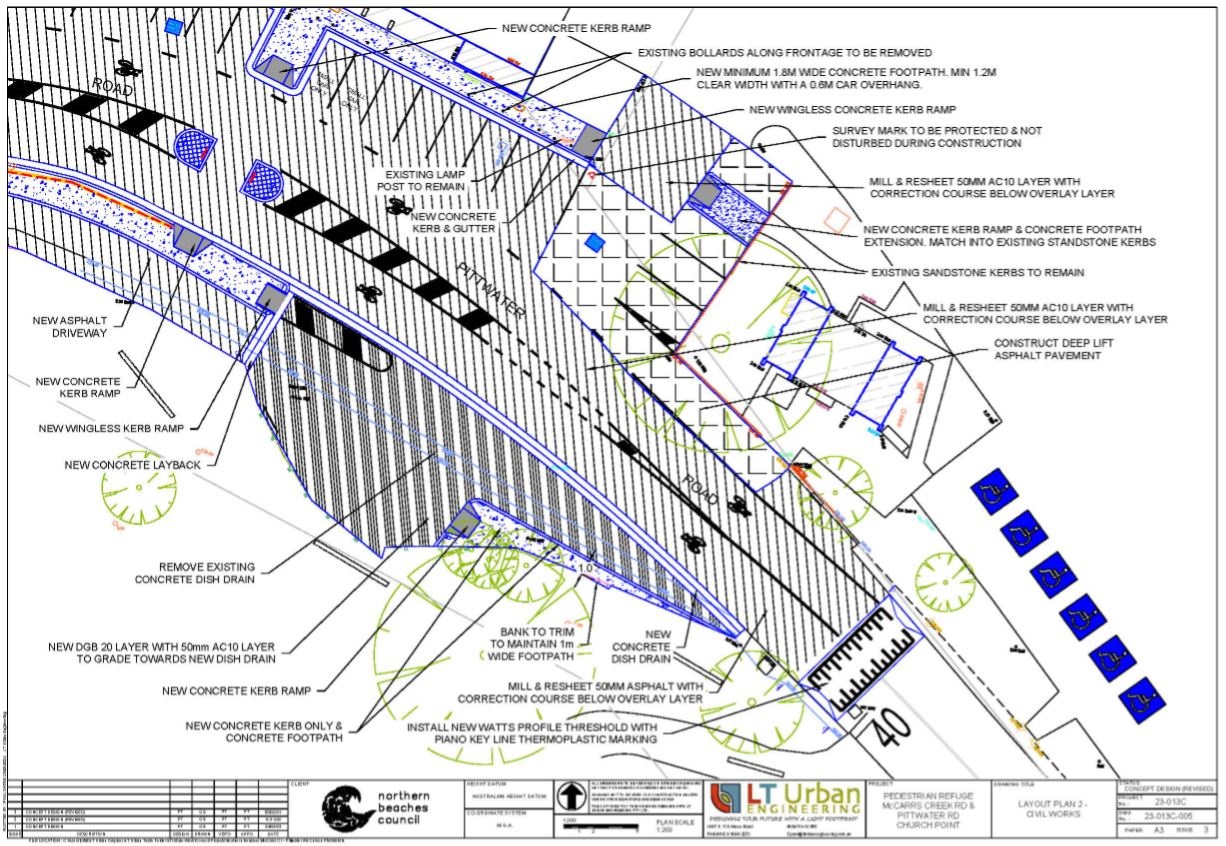
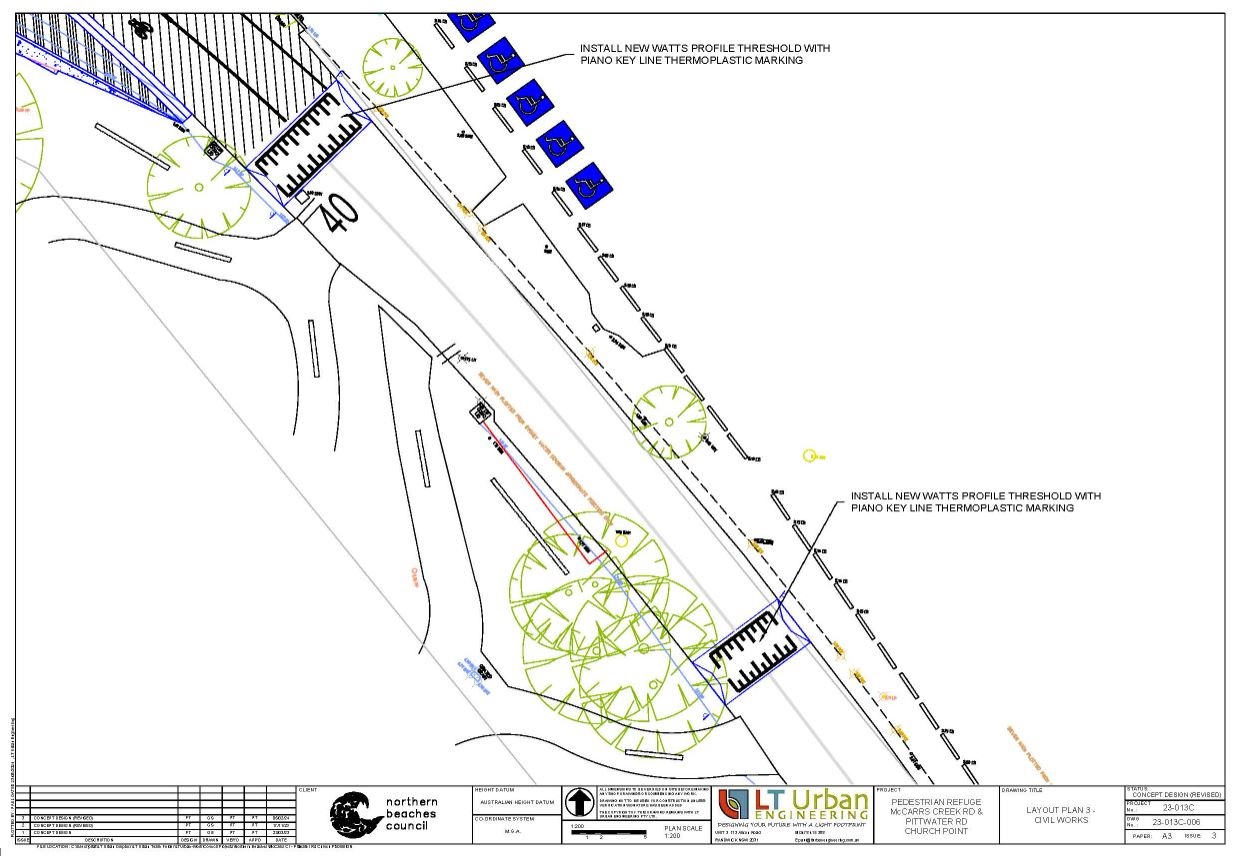
Council states it is planning for all works to be complete prior to Summer 2025-2026.
''The landscape works will be scheduled to commence once the road works are completed and budget is confirmed. At this time we hope to commence the landscape works mid-late 2025.'' Council states on its Thomas Stephens Reserve, Church Point Landscape improvements project webpage.